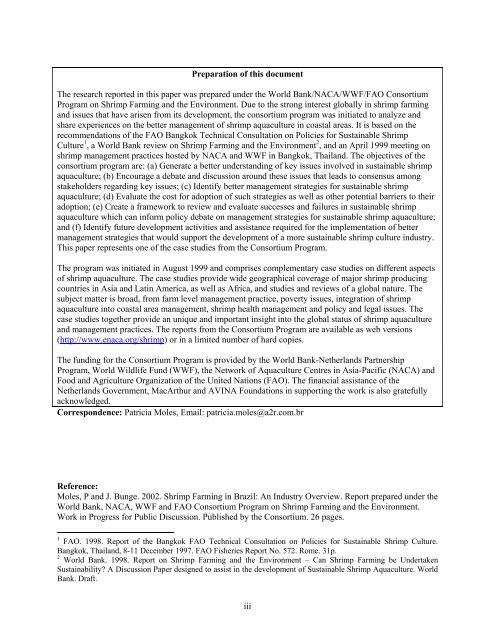Shrimp Farming in Brazil: An Industry Overview - Library - Network of ...
Shrimp Farming in Brazil: An Industry Overview - Library - Network of ...
Shrimp Farming in Brazil: An Industry Overview - Library - Network of ...
You also want an ePaper? Increase the reach of your titles
YUMPU automatically turns print PDFs into web optimized ePapers that Google loves.
Preparation <strong>of</strong> this document<br />
The research reported <strong>in</strong> this paper was prepared under the World Bank/NACA/WWF/FAO Consortium<br />
Program on <strong>Shrimp</strong> <strong>Farm<strong>in</strong>g</strong> and the Environment. Due to the strong <strong>in</strong>terest globally <strong>in</strong> shrimp farm<strong>in</strong>g<br />
and issues that have arisen from its development, the consortium program was <strong>in</strong>itiated to analyze and<br />
share experiences on the better management <strong>of</strong> shrimp aquaculture <strong>in</strong> coastal areas. It is based on the<br />
recommendations <strong>of</strong> the FAO Bangkok Technical Consultation on Policies for Susta<strong>in</strong>able <strong>Shrimp</strong><br />
Culture 1 , a World Bank review on <strong>Shrimp</strong> <strong>Farm<strong>in</strong>g</strong> and the Environment 2 , and an April 1999 meet<strong>in</strong>g on<br />
shrimp management practices hosted by NACA and WWF <strong>in</strong> Bangkok, Thailand. The objectives <strong>of</strong> the<br />
consortium program are: (a) Generate a better understand<strong>in</strong>g <strong>of</strong> key issues <strong>in</strong>volved <strong>in</strong> susta<strong>in</strong>able shrimp<br />
aquaculture; (b) Encourage a debate and discussion around these issues that leads to consensus among<br />
stakeholders regard<strong>in</strong>g key issues; (c) Identify better management strategies for susta<strong>in</strong>able shrimp<br />
aquaculture; (d) Evaluate the cost for adoption <strong>of</strong> such strategies as well as other potential barriers to their<br />
adoption; (e) Create a framework to review and evaluate successes and failures <strong>in</strong> susta<strong>in</strong>able shrimp<br />
aquaculture which can <strong>in</strong>form policy debate on management strategies for susta<strong>in</strong>able shrimp aquaculture;<br />
and (f) Identify future development activities and assistance required for the implementation <strong>of</strong> better<br />
management strategies that would support the development <strong>of</strong> a more susta<strong>in</strong>able shrimp culture <strong>in</strong>dustry.<br />
This paper represents one <strong>of</strong> the case studies from the Consortium Program.<br />
The program was <strong>in</strong>itiated <strong>in</strong> August 1999 and comprises complementary case studies on different aspects<br />
<strong>of</strong> shrimp aquaculture. The case studies provide wide geographical coverage <strong>of</strong> major shrimp produc<strong>in</strong>g<br />
countries <strong>in</strong> Asia and Lat<strong>in</strong> America, as well as Africa, and studies and reviews <strong>of</strong> a global nature. The<br />
subject matter is broad, from farm level management practice, poverty issues, <strong>in</strong>tegration <strong>of</strong> shrimp<br />
aquaculture <strong>in</strong>to coastal area management, shrimp health management and policy and legal issues. The<br />
case studies together provide an unique and important <strong>in</strong>sight <strong>in</strong>to the global status <strong>of</strong> shrimp aquaculture<br />
and management practices. The reports from the Consortium Program are available as web versions<br />
(http://www.enaca.org/shrimp) or <strong>in</strong> a limited number <strong>of</strong> hard copies.<br />
The fund<strong>in</strong>g for the Consortium Program is provided by the World Bank-Netherlands Partnership<br />
Program, World Wildlife Fund (WWF), the <strong>Network</strong> <strong>of</strong> Aquaculture Centres <strong>in</strong> Asia-Pacific (NACA) and<br />
Food and Agriculture Organization <strong>of</strong> the United Nations (FAO). The f<strong>in</strong>ancial assistance <strong>of</strong> the<br />
Netherlands Government, MacArthur and AVINA Foundations <strong>in</strong> support<strong>in</strong>g the work is also gratefully<br />
acknowledged.<br />
Correspondence: Patricia Moles, Email: patricia.moles@a2r.com.br<br />
Reference:<br />
Moles, P and J. Bunge. 2002. <strong>Shrimp</strong> <strong>Farm<strong>in</strong>g</strong> <strong>in</strong> <strong>Brazil</strong>: <strong>An</strong> <strong>Industry</strong> <strong>Overview</strong>. Report prepared under the<br />
World Bank, NACA, WWF and FAO Consortium Program on <strong>Shrimp</strong> <strong>Farm<strong>in</strong>g</strong> and the Environment.<br />
Work <strong>in</strong> Progress for Public Discussion. Published by the Consortium. 26 pages.<br />
1 FAO. 1998. Report <strong>of</strong> the Bangkok FAO Technical Consultation on Policies for Susta<strong>in</strong>able <strong>Shrimp</strong> Culture.<br />
Bangkok, Thailand, 8-11 December 1997. FAO Fisheries Report No. 572. Rome. 31p.<br />
2 World Bank. 1998. Report on <strong>Shrimp</strong> <strong>Farm<strong>in</strong>g</strong> and the Environment – Can <strong>Shrimp</strong> <strong>Farm<strong>in</strong>g</strong> be Undertaken<br />
Susta<strong>in</strong>ability? A Discussion Paper designed to assist <strong>in</strong> the development <strong>of</strong> Susta<strong>in</strong>able <strong>Shrimp</strong> Aquaculture. World<br />
Bank. Draft.<br />
iii

















